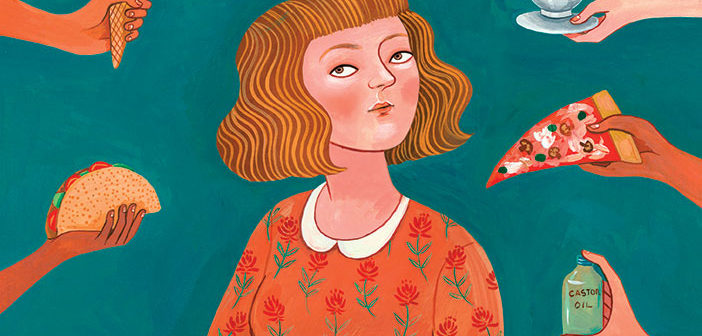What’s true and what’s bunk about pregnancy.
Parents have been trying to choose the sex of their baby for millennia, and to this day they’re willing to believe some pretty strange things will do the trick—like eating sugar to conceive a girl, or sleeping on the right side to get a boy.
“There’s always going to be a 50 percent chance that someone is right, and so [these superstitions]keep getting repeated over and over,” says Jonathan Schaffir ’87 MD’90, the author of What to Believe When You’re Expecting, a collection of pregnancy folklore passed down through the ages and what science has to say about it.
Schaffir has been collecting these “old wives’ tales” over his more than 20 years in practice as an obstetrician/gynecologist. As patients kept coming to him with the same stories, he says, he started wondering if there might be any truth to them.
“Something I hear very, very frequently: ‘oh, this baby must have a lot of hair because I have so much heartburn,’” he says. “There’s one study that actually does show some evidence that there’s an association. I don’t know that I completely buy that explanation, but there you have it, someone actually looked at that.”
“These must be researchers with a good amount of time on their hands,” he adds.
An associate professor at The Ohio State University College of Medicine, Schaffir studies psychosocial topics in women’s health in addition to seeing patients. But his first published paper was on sex selection beliefs, which he wrote as a fourth-year med student. “The idea stuck with me,” he says.
He was surprised by the staying power of some myths, which have found new (and amplified) life online. “But I would say the majority of advice that is not scientific is also pretty innocuous,” Schaffir says.
For most of history, he adds, medical texts were written by men who may not have seen fit to record the knowledge of midwives and other women who helped with childbirth. Now “anyone can be an author” on the internet, Schaffir says. “Women are taking these matters into their own hands.”
Read on for some of the fascinating folklore Schaffir explores in his book. But take it with a grain of salt. “I’m not recommending that people actually use any of these methods, because I don’t think safety has been well-established,” he says.
Get Going
The notion that laxatives could also work to move a baby was a common one by the early 20th century. Though it fell out of favor as oxytocin came on the scene, “there actually is quite a bit of medical evidence that laxatives, particularly castor oil, may stimulate labor,” Schaffir says. Some providers still recommend it—though, as he writes in his book, it’s not without some risk. Not to mention it entails “subjecting a woman to the discomforts of diarrhea on top of the discomforts of nine months of pregnancy.”
A tastier internet remedy to induce labor is spicy food, and it, too, may have some basis in fact. “Of course,” Schaffir writes, “a woman who is past her due date and hoping to deliver soon might go into labor regardless of how many jalapeños she adds to her plate.”
Spice it Up
Since ancient times physicians have cautioned nursing women to avoid strong flavors—like onion, mint, and pepper—lest they render their breast milk unpalatable. Above all, the experts said, no garlic. Studies have confirmed that some spices and other foods are indeed detectable in milk, though the taste of the longest lasting, menthol, was gone after eight hours. And garlic, it turns out, gets babies to nurse longer.
Science has validated the caveat that foods that can cause indigestion may also upset a nursing infant’s delicate GI tract. Researchers found that the babies of women who’d eaten cruciferous vegetables like broccoli and brussels sprouts were more likely to be colicky. That said, Schaffir writes, “it may be unwise to restrict breastfeeding women from an entire class of otherwise healthy vegetables.”
Cheers?
Nursing moms perusing medical texts from the late 1800s for guidance to boost their milk supply might learn that one or two beers a day would do the trick. It’s a notion that dates back to at least ancient Egypt, and Schaffir still hears it from patients. But studies show alcohol is actually counterproductive for this purpose. “There may be something else in beer, in the barley or hops, that does improve milk supply, so maybe a nonalcoholic beer may be helpful,” he adds.
Hard Pass
Hydrating to ease labor is a recurring theme through the ages. Red raspberry leaf tea is a centuries-old remedy that The Lancet once called “a proved aid” but didn’t stand up to more recent scrutiny. At least it’s harmless; the same can’t be said for the ancient Roman counsel to drink water mixed with powdered dung, or, from India, water into which the pregnant woman’s mother-in-law had dipped her big toe.
Telltale Heart
Clues to predict a baby’s sex are right half the time, so even clearly unscientific beliefs persist. But unlike, say, holding a chain over the mom-to-be’s belly to see which way it swings, measuring fetal heart rate sounds legit. Since sometime in the 19th century, when this became possible, the theory that female fetuses have faster heartbeats than males has been advanced and debunked. Yet the idea lives on—and, Schaffir says, “I think it has gotten more and more common as people repeat it.”
Iron Chef
From clay or dirt to ice cream with pickles, most women crave some peculiar fare when they’re pregnant. Long considered a signal of what the baby (or the body) needs, providers and the public alike worried that denial would endanger the fetus and the mother. We know now that neither serious illness nor unsightly birthmarks are the likely result of thwarted cravings, but researchers still aren’t sure what drives pregnant women’s intense desires for certain foods, though it’s almost certainly psychological.
While some cravings are so foul they’re funny, others are potentially hazardous, like pica, an appetite for ashes, eggshells, and other inedibles. Scientists have investigated whether minerals or antimicrobial properties in some of these substances could explain this inexplicable hunger, but have come up empty. It could be worse, though, Schaffir notes, recounting a few tales of cannibalism. So, go ahead and put brownies on your pizza. Just don’t eat too much.
Rough Riders
For centuries women have tried bouncing, jumping, and riding horses to jostle an overdue baby out of the womb. From tossing a pregnant woman in a blanket to hanging her upside down and shaking her, some old practices are downright barbaric, and certainly “far worse than the discomfort of being pregnant for a few more days,” Schaffir writes. But the notion lives on in modern suggestions of strenuous exercise and bumpy car rides. Given the risk of internal bleeding and worse, he doesn’t recommend it.
Walking to induce labor also has its long-time adherents, and though not harmful for most women late in pregnancy, the evidence that it will trigger childbirth is scant. Similarly, while regular exercise is healthy for most women, it’s unlikely to help them deliver any sooner.
Ounce of Prevention?
Burying the placenta is a time-honored tradition in many cultures. Eating it, though, is a curiously recent phenomenon—“a function of the internet,” Schaffir says, among women sharing their pregnancy stories. Placentophagy is relatively common among other mammalian moms; supposedly, in humans, doing so can speed recovery, prevent postpartum depression, and boost milk production. But no studies have borne these claims out.
And it’s not without risk; while some women cook and eat their placenta after giving birth, others send it out to be encapsulated by processors that aren’t licensed or supervised, Schaffir says—so the pills’ safety is questionable.
Still, he’s sympathetic with proponents of the practice. “That particular recommendation comes out of a frustration with the lack of understanding about some of the postpartum complications,” he says. “I think someone will be willing to try anything to avoid those problems … because there aren’t a lot of other preventive things out there that are known to be effective.”
FIND THE BOOK: What to Believe When You’re Expecting: A New Look at Old Wives’ Tales in Pregnancy By Jonathan Schaffir ’87 MD’90 ROWMAN & LITTLEFIELD, $30




